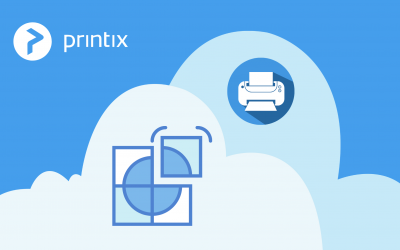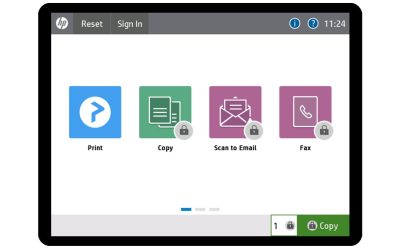Time to throw out the print server – you can handle print in the cloud
As companies move to cloud-based solutions, the demands on freedom of print also increase. Is it time to delete your own print server and instead use a cloud service? We have tested.
TechWorld Sweden has tested Printix. Here is an unofficial translation of the review written by Henrik Elmsjö.
November 10, 2018 – More and more companies are heading towards cloud-based services and strive to reduce their local infrastructure. Sooner or later, the turn comes to printing and today you’re probably more interested in a more modern solution than one that works in the same way as in the 1990s. We have taken a look at how to design a modern print solution today and as an example, we have chosen the product Printix.
The reason we chose to test this product as a concept is that it is representative of how a modern print solution works, for example, Printix integrates with the directory service Azure AD, where all users already have work accounts using Office 365 and it also supports Google Accounts. You can also have completely separate accounts for Printix, but then much of the integration is lost. Integration with global directory services also means that you can easily get good security with two-factor login and other identity security services. Printix does not require any local infrastructure at all and is in fact, used primarily in a 100% cloud environment where your Windows Clients join directly in Azure AD instead of a local AD.
Our scenario here is a company that already runs Office 365 and now wants to expand its cloud integration and get rid of its old print servers. There are of course more products on the market that fit this scenario and offer similar features. Everything from Google Print, which may be most suitable for end users and home users, to more similar competitors like ezeep, EveryonePrint and PrinterOn.
You start your subscription by logging in with your Office 365 account and then giving Printix permission to access your environment. After this you download and install a Printix Agent on the client. Then you can either start from a properly configured client and make a “clone” of its print queues up to Printix, or let Printix start from scratch, search your network for printers, and optimize drivers and queues with the result.
You also need to teach Printix about your network and which sites it consists of so that later, you can control which print queues are to be distributed to your clients and you always have access to a local print queue wherever you are.
You can also configure a printer to be a “cloud driver”, which means that it is always possible to print to it, wherever the user is. This works great from home or anywhere where you have internet connection but requires that at least one other Printix client is available on the network where the printer is located. In a larger workplace, this is probably rarely a problem, but in smaller workplaces you may need to install the Printix client on a server or other Windows device that is always running on the network.
You can see overall print job statistics in various areas, but you cannot view this at a user level. Perhaps not the most important feature, but it would have been a nice addition to getting that information.

Different configurations can be created on print queues, with specific stapling setting, double sided, etc., and sent as a separate print queue to a computer. You can also update an existing print queue with new settings. You can send print queues to computers or to users based on groups in Azure AD. No changes need to be made in firewalls, as the agent manages all communication and no connections need to be initiated from the outside.
We were missing a feature that would have been nice and that was to be able to specify which default print queue a user should have on the client. In many cases, Windows allows you to handle this, but it would still be a nice feature to have. You can also specify that a print job should be “retained”, and then release it from a computer or mobile App when you want it. This can be valuable when you print sensitive data and want to save on paper. The user also receives a general print queue installed, Printix Anywhere. If you print to this queue, the print job is held back, and later you can choose which physical printer you want it printed on. Of course, this can also be done via the mobile App.
If you are going all the way to a pure cloud environment, where you no longer have a local AD left, but your clients are members directly in Azure AD, you get completely transparent print management where noting more needs to be done, as long as the agent is installed. This may be a way off for many companies but it’s something that more and more strive for today. All in all, our impression is very positive, and it is quick and easy to work with Printix. Even though it is a relatively young product, it feels mature and stable and a worthy successor to our old print servers that have served us well for over twenty years but now it is worth retiring.
TECHWORLD TEST
Product: Printix.
Manufacturer: Printix.
Price: SEK 20.60 per user and month. Minimum price 310 SEK / month.
Initial configuration: Quick to get started. Can reuse existing print queues and move them to the cloud or quickly scan the network for printers. Agent is installed on clients manually, via script, Intune, SCCM, etc.
Interface: Stylish, modern and easy to use for end users and administrators. Easy-to-use mobile App.
Additional Features: Allocate printers based on IP networks and / or groups in Azure AD. Release print with App. Virtual print queue is available, where you can select printer afterwards. Support for Chromebooks.
Benefits: Ready for the future with good integration in Azure AD. Very easy-to-use, all printer configuration takes place automatically. You do not need local print servers. Nice statistics on prints.
Cons: Cannot set default printer, which would have been useful.
Rating: 90/100
TechWorld is the forum that Swedish IT professionals
Source: TechWorld from IDG.SE 2018-11-10 07:01




